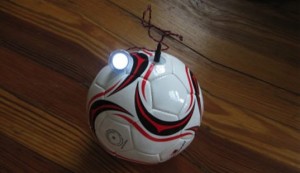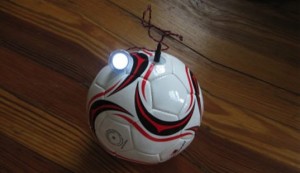 How would you fancy if your favorite electronic gadget could be charged by the world’s favorite sport? Well, you might not have to imagine for long thanks to a group of Harvard students.
How would you fancy if your favorite electronic gadget could be charged by the world’s favorite sport? Well, you might not have to imagine for long thanks to a group of Harvard students.
With millions of soccer enthusiasts all over the world eagerly awaiting the final stages of Euro cup 2012, we’re quite confident that their television sets shall be occupied for the majority of the next couple of weeks. On the other hand, with the ever increasing cost of living, those exact millions of enthusiasts shall spend the rest of their impending future trying to pay off the unreasonably high electricity bills just for the sake of keeping their lights on!
A group of Harvard students have taken it upon themselves to attempt to solve these issues with the new innovative Soccket; a soccer ball that is meant to be kicked through the air in order to grasp otherwise wasted energy that is inaugurated by forces drilled onto the ball during play.
So how does this ball actually work you ask? Well, it is waterproof, sturdy and does not require to be inflated. It implements inductive coil technology which involves having a metal coil and magnetic slug that goes forwards and backwards. This motion powers a motor, and the electricity is then stored in an on-board battery.
An AC adaptor is suitably put behind one of the panels of the Soccket so as to allow a multitude of appliances to be powered in such a manner. The quintet which is made up of : Jessica Lin, Julia Silverman, Jessica Mathews, Hemali Thakkaras and Aiva Presser, had conceptualized a better use for this ball and which is to charge mobile devices as well as power lights.
Even though we do not know how excited American soccer fans will actually be by the idea of a ball that could charge their iPhone, the quintet aspire their invention serves a more purposeful mean.
In many developing countries, due to the fact that electricity is a mere luxury, reliance on kerosene lamps has led to numerous health problems.
The World Bank estimates that breathing the fumes created from burning kerosene indoors equates to the harmful effect of smoking two packs of cigarettes a day.
Burning kerosene for lighting also generates some 190 million metric tons a year of carbon dioxide emissions, according to recent estimates — the equivalent emissions of about 38 million automobiles.
Thus, soccer often captivates near-religious attention from the vast majority of such poor population. These devoted people not only show up for every single match and idolize the big names of this sport, yet they also spend long hours practicing the game whenever they possibly can. Hence, the Soccket could be employed to obtain energy from such spontaneous soccer games that could then be used to actually power lights or heat sources.
It’s definitely more than just your typical ball isn’t it? Apparently Bill Clinton thinks so as well. Check out the video below to see for yourself:
Yet, on a more realistic note, the question is related to the technological components of this ball and how they actually affect the performance of the ball. The added weight caused by the device’s magnet might turn off many prospective players, making it highly unlikely to be actually adopted as the preferred alternative. Think of it, would you risk a head concussion for the purpose of keeping the lights on in your house?
![]()

Looking for a simple, elegant backup solution?
Genie Timeline 2012 is a new version of the number one continuous data protection program Timeline 2.1. It offers the first metro style user interface; enhanced performance, and added features. Like us on Facebook and Follow us on Twitter for the latest news.
>Follow @Genie9backup
![]()

